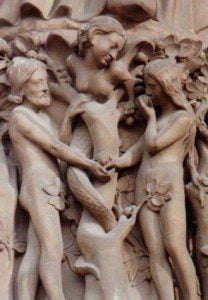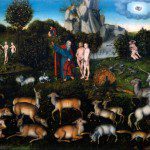 The next section in Four Views on the Historical Adam centers on the view of Adam put forth by C. John Collins. He takes an old earth special creation view, but is willing to consider a wide range of scenarios that fit within certain limits. For example, he seems fine with an evolutionary description of the appearance of animal life if this is where the evidence leads. However, he does not think humans can be fit neatly into an evolutionary picture, scientifically or theologically.
The next section in Four Views on the Historical Adam centers on the view of Adam put forth by C. John Collins. He takes an old earth special creation view, but is willing to consider a wide range of scenarios that fit within certain limits. For example, he seems fine with an evolutionary description of the appearance of animal life if this is where the evidence leads. However, he does not think humans can be fit neatly into an evolutionary picture, scientifically or theologically.
C. John (Jack) Collins is a Professor Old Testament at Covenant Theological Seminary in St. Louis Missouri. He has published a number of books relating to the interpretation of Genesis in general and Adam in particular: Science and Faith: Friends or Foes?, Genesis 1-4: A Linguistic, Literary, and Theological Commentary, and Did Adam and Eve Really Exist?: Who They Were and Why You Should Care. I posted previously on his article in the ASA Journal Perspectives on Science and Christian Faith (How Much History in Gen 1-3) and a long series on his book on Adam: The Search For the Historical Adam One, Three, Four, Five, Six, Seven, Eight, Nine (Two in the series focused on the Christianity Today article on Adam which was not by Collins). His essay in this book draws heavily on these previously published materials and you can find a more detailed interaction with his ideas in the previous posts.
I will say at the outset that Jack Collins is among my favorite writers on the issues of science and faith, Adam, and the interpretation of Genesis 1-4; not because I agree with his position – there are a number of places where I take a significantly different view – but because he deals fairly with those who disagree with him and lays out his argument clearly. His aim is not to provide “right” answers, but to help Christians think through the issues critically and carefully and to explain the reasoning behind his view. This provides the opportunity to start a meaningful conversation on the issues.
History. Collins begins his essay by discussing the meaning of history and historical as this lays the necessary ground work for approaching Genesis 2-3. He makes three major points (p. 148):
- “historical” is not the same as “prose,” and certainly does not imply that our account has no figurative or imaginative elements.
- “historical is not the same as “complete in detail” or “free from ideological bias,” neither is possible or desirable anyhow.
- “historical” is not necessarily the same as “told in exact chronological sequence” unless the texts claims that for itself.
The presence of figurative and imaginative elements does not mean that there is not a historical core based on events that really happened. Clearly there are figurative and imaginative elements in Genesis 2-3, but the text can, and in Collins’s view does, relate history using these elements.
Genesis 1-11 is a unity. Genesis is an ancient Near Eastern document both similar to and different from the contemporary stories and writings that have been uncovered and translated. Collins notes that the overarching pattern of Mesopotamian culture and literature “provides a literary and ideological context into which Genesis 1-11 speaks, and it does so as a whole.” (p. 150) It doesn’t do for us to rip it apart and examine the bits and pieces separately without considering also the whole. It may well have been edited together from different sources, but they were edited together to make a coherent whole on a conceptual, literary and linguistic level. This isn’t an amateur patchwork quilt of texts. Each piece comes together to make the whole.
Genesis 1-11 is a front end to the rest of Genesis and indeed to the whole of scripture that aims to set the stage for the story in the right way, founded in a worldview with God and his action at the center. One key distinction from the Mesopotamian background is that humankind as a whole was created in the image of God and placed in God’s creation. This unity of humankind and the imago Dei are important for the conclusions Collins draws later.
The Biblical Story Line. Collins’s understanding of the overall story line of scripture drives his understanding of Adam and Eve. The Bible has a story line that “tells us who we are, where we came from, what is wrong, and what God is doing about it.” (p. 158) Adam and Eve are essential elements in the story line.
The Old Testament is thus the story of the one true Creator God who called the family of Abraham to be his remedy for the defilement that came into the world through the sin of Adam and Eve. God rescues Israel from slavery in Egypt in fulfillment of this plan, and established them as a theocracy for the sake of displaying his existence and character to the rest of the world. God sent his blessings and curses upon Israel in order to pursue that purpose. God never desisted from that purpose, even in the face of the most grievous unfaithfulness of Israel.
…
The New Testament authors … saw themselves as heirs of the older story and as authorized to describe its proper completion in the death and resurrection of Jesus and the Messianic era that this ushered in. … [T]hey saw the Old as constituting the earlier chapters of the story in which Christians are now participating. (p. 158-159)
The unity of humanity, the presence of Adam and Eve at the headwaters of the human line, the reality of their sin and the transmission of this sin to all of humanity is, in Collins view, an essential historical element of this story line. The estrangement from God that we experience is unnatural and out of step with how things ought to be. Sin is an alien intruder that disturbs God’s good creation order.
Revelation 22 portrays the consummation as a Eden come to fruition. The place described in Revelation (using symbolism and figurative language) is a sanctuary, a holy place, as the garden in Genesis 2-3 was a sanctuary, a holy place.
Paul places the human experience in this story line. And his comparison of Adam and Jesus depends on this narrative.
That is, someone did something (one man trespassed, Rom 5:15), and as a result something happened (sin, death, and condemnation came into the world of human experience), then Jesus came to deal with the consequences of it all (by his obedience to make the many righteous). The argument gains its coherence from its sequence of events; it is drastically inadequate to say that Paul is merely making a “comparison” here. Further, consider the notion that people are “in Adam” or “in Christ”: to be in someone is to be a member of that people for whom that someone is the representative. All the evidence we have indicates that only actual persons can function as representatives. (p. 163-164)
An important consequence of this story line is that sin is not inherent in being human with a free will. It is a horrific aberration resulting from someone’s disobedience. If this is not the case it undermines the entire notion of atonement through the blood of Christ as described in scripture. According to Collins if this is not the case “[w]e must say that the Bible writers were wrong” and that “Jesus was wrong” when he described his death as a ransom for many in Mark 10:45.
Adam and Eve and the Origin of Humanity. The story line leads us to expect that humankind is all one family, that “God acted specially (“supernaturally”) to form our first parents, and our first parents at the headwaters of humanity brought sin and dysfunction into the world of human life.
Collins argues that there are factors in our make up that are universally human and uniquely human. These go beyond the powers of natural processes. Our capacity for language is one of these. The difference between human and animal language are not merely differences of degree but differences of kind, that is “human language is discontinuous with animal communication.” (p. 165) This difference is inherent in what we are – a human child is built to acquire sophisticated structured language. A chimpanzee or gorilla simply does not have the capacity to move beyond a rudimentary level. Art is another example.
According to Collins:
It is simply unreasonable to suppose that one can arrive at human capacities without some “help” from outside; that is good reasoning includes recognizing that God’s creative activity is involved. (p. 170)
Evolutionary intermediate processes may (or may not) have occurred. Collins isn’t dogmatic on this point, and he acknowledges that he isn’t conversant in the biology. In his view animal death is not a theological problem and is not a consequence of the fall. But there must be an event of special creation in the formation of humans, an event that involves distinction from all other animal life. He does object to some forms of theistic evolution – and Adam and Eve are at the center of this objection. As he puts it: “I find that the strongest form of theistic evolution is inadequate, both for Bible and for historical science, since it fails to account for human distinctiveness.” (p. 173)
Freedoms and Limitations. There are a range of possible interpretations of Genesis 2-3 that are consistent with the overarching story line of the Bible. Collins provides four criteria that he provide ground rules for thinking about Adam and Eve and the origin of humanity. (Quoted from pp. 171-172)
- The origin of the human race goes beyond a merely natural process. This follows from how hard it is to get a human being or, theologically, how distinctive the image of God is.
- Adam and Eve are at the headwaters of the human race. This follows from the unified experience of humankind.
- The “fall,” in whatever form it took, was both historical (it happened) and moral (it involved disobeying God), and it occurred at the beginning of the human race. Our universal sense of loss makes no sense without this. Where else could this universality have come from?
- If someone should become convinced that there were, in fact, more human beings than just Adam and Eve at the beginning of humankind, then in order to maintain good sense, he or she should envision these as a single tribe of closely related members. Adam would then be the chieftain of this tribe (produced before the others) and Eve would be his wife. This tribe “fell” under the leadership of Adam and Eve. This follows from the notion of solidarity in a representative.
Collins does agree that there is some support for the existence of a larger group of humans, more than just Adam and Eve and their children in Genesis 4. This is indicated by the concerns and actions of Cain after he kills Abel and with his legacy. And, of course, however we imagine Cain got his wife we have to go beyond the text of Genesis in our inference.
This is, as it is billed in the book, an old-earth creation view, but it is a fairly flexible view of old-earth creation.
In the next post on the book we will look at the responses offered by Denis Lamoureux, John Walton, and William Barrick as well as the rejoinder from Jack Collins and my own thoughts on the subject. For now:
What do you think of the limits Collins proposes?
Does the image of God require special creation? If so, how?
Does the doctrine of atonement require Adam and Eve at the headwaters of the human race?
If you wish to contact me directly you may do so at rjs4mail [at] att.net.
If interested you can subscribe to a full text feed of my posts at Musings on Science and Theology.















